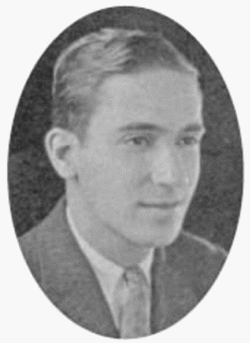

Queer Places:
Lyons Plain Cemetery
Weston, Fairfield County, Connecticut, USA
 Joseph Hamilton Basso (September 5, 1904 – May 13, 1964)[1] was an American novelist and journalist.
Joseph Hamilton Basso (September 5, 1904 – May 13, 1964)[1] was an American novelist and journalist.
Ham Basso was the son and grandson of Italian immigrants and spent his first years in the French Quarter, but the Bassos were Northern Italian and middle-class, not poor Sicilians like most of their neighbors. After Grandfather Joseph Basso died, the family sold his shoe factory on Decatur Street and moved with young Ham from their place above it to the “American” Mid-City section of town. This was part of a larger pattern of assimilation: Mrs. Basso was a devout Catholic, but went to an Episcopal Church in the wintertime for the central heat, and Ham went not to Loyola but to Tulane, where he styled himself “J. Hamilton Basso.”
At Tulane he was the editor of an award-winning yearbook and a BMOC, put in the annual “Hall of Fame” his senior year and elected to the most prestigious honorary society. A practical joker, a good dancer, and something of a dandy, who favored white suits and maroon ties, he was also, according to one profile, “the reputed and recognized champion of Tulane University at the scholarly custom of beating checks” (i.e., getting cash to the bank before his bad checks bounced). Later, Elizabeth Anderson would recall that Basso “had no money at all except what he could borrow here and there” and that “he rarely gave much thought to returning the borrowed money, but he was young and very excited about writing.”
Like Freddie Oechsner, his near-contemporary at Tulane, Basso studied law but preferred literature—especially after the Double Dealer accepted a couple of his poems and he started hanging out with the French Quarter crowd. He was part of the group that met at the Pelican Bookshop after closing for wine and sandwiches, and he met Bill Faulkner at one of the Andersons’ regular Saturday suppers. (Still a prankster, he once arranged to have a brick covered in sauce, baked, and served to Sherwood at a restaurant.) He showed up for the Andersons’ Lake Pontchartrain cruise with a “giddy young girl,” and was mentioned in the society pages as part of “a notable gathering of the social world” to be seen at an Arts and Crafts Club ball. He and Faulkner took long walks together along the wharfs, talking about faroff places, books they’d been reading, “and, inevitably, the South,” but their bond was cemented when Basso was assigned to write about the Gates Flying Circus for the Times-Picayune and the two young men went up together a few times. “Nobody else in our crowd had gone looping-the-loop in a bucket seat and open cockpit over the Mississippi River.” The whole scene, he said later, was “fun” and “something to be ‘in’ on,” although he confessed that “I was bound, having just turned twenty and still enrolled at Tulane University, to wonder occasionally if I had not been admitted into the ball park by mistake.”
At the time Basso was writing for several New Orleans dailies. Shortly before graduation, he dropped out of Tulane—to ensure, he said, that he would never have to be a lawyer—and took a full-time reporting job with the Tribune, then one with the Times-Picayune. He wrote notable features on the waterfront and on crime. In June 1926, he left to seek fame and fortune in New York, but after less than six months of trucking freight and working in a department store, homesick and lonely, he came home to work seriously on his first novel.
To make ends meet, Basso worked as a reporter for the Item, then took a job with an advertising agency (which he came to hate), but he finished Relics and Angels in 1928 and it was published the next year. Meanwhile, he had been seeing Etolia “Toto” Simmons, a Newcomb graduate from St. Louis who worked for the Pelican Bookshop. He proposed to her over dinner at Galatoire’s, and they were married in 1930. When Basso lost his advertising job— because of his “complete and even appalling lack of ability as a copywriter,” he said, although the Depression probably contributed—the young couple moved to a $10-a-month cabin in the North Carolina mountains, where he worked on a biography of the Creole Confederate general, P.G.T. Beauregard.
The Bassos never lived again in New Orleans—they settled in suburban Connecticut in 1942—but Ham stayed in touch with friends like Lyle Saxon. He worked successively for New Republic, Time, and the New Yorker, and he published eight more novels before 1954, when The View from Pompey’s Head spent forty weeks on the bestseller list and was sold to Twentieth Century-Fox. After that success, Basso was elected to the National Institute of Arts and Letters, and he wrote three more novels—The Light Infantry Ball was a finalist for the National Book Award in 1960—before his death from lung cancer in 1964.
In 1926 Pelican Bookshop Press, New Orleans, published "William Spratling and William Faulkner, Sherwood Anderson and Other Famous Creoles: A Gallery of Contemporary New Orleans", issued in 250 copies. The “Famous Creoles” (with ages in 1926) were
My published books: